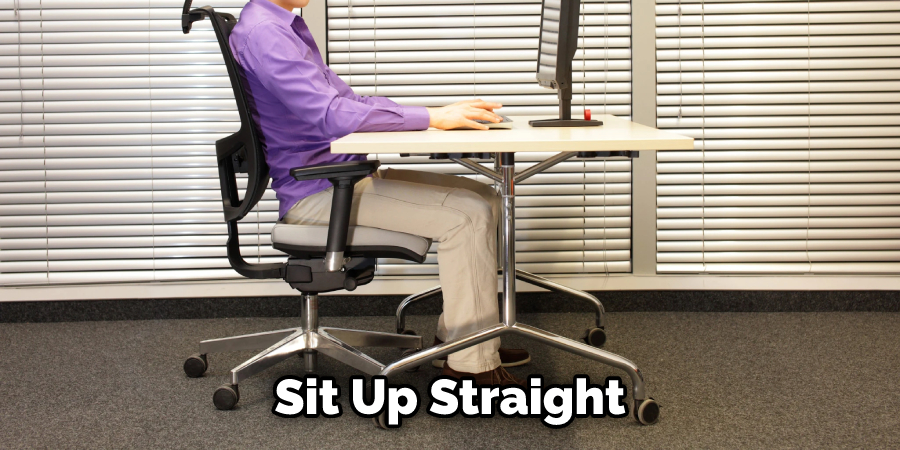Maintaining proper posture while sitting in an office chair can have huge benefits for not just your work but also your overall health. Poorly designed chairs or incorrect positioning of the body can cause muscle strain and misalignment of the spine – these can easily be avoided with a few simple tips on how to properly sit in an office chair.

In this blog post, we’ll cover the basics of optimal seating arrangements and give advice on how to ensure you’re getting both comfort and support from your seat. Read on for some great ways to beat aches and pains caused by sitting all day!
What Is the Best Posture to Sit on a Chair?
When sitting on an office chair, it is important to maintain the correct posture. This means that your spine should be kept straight, with your shoulders and head held in a neutral position. Your feet should be planted flat on the ground with your knees bent at a 90-degree angle or higher.
Maintaining this posture will help you avoid back strain and any other potential injuries. Additionally, having good posture can also help improve concentration and productivity while working.
It is also important to adjust the height of the chair so that your thighs are parallel to the floor, allowing for maximum comfort when sitting for long periods of time.
Additionally, if available, using an armrest while typing may reduce shoulder tension and strain on wrists by keeping them in a neutral position. Lastly, it is beneficial to take regular breaks throughout the day and stretch out your body – especially your legs and arms- to avoid muscle fatigue.
By following these tips, you can maintain good posture while sitting on an office chair and ensure that your workday is comfortable as well as productive.
7 Methods How to Properly Sit in an Office Chair
1. Sit up Straight

One of the most important things you can do when sitting in an office chair is to sit up straight. This means aligning your spine so that it is perpendicular to the ground. This may require you to adjust the backrest of your chair so that it supports your lower back.
Additionally, you should avoid slouching or hunching over, as this can put a strain on your spine. If you find it difficult to sit up straight for long periods of time, try taking frequent breaks and stretching your back.
Once you’ve found a comfortable and supportive posture, it’s important to maintain it. Make sure to keep your shoulders relaxed and chin up.
2. Use a Footrest
If your feet do not reach the ground when you are sitting in your office chair, it is important to use a footrest. This will help to keep your feet from dangling, which can cause pain in your legs and back.
Additionally, a footrest will help to keep your legs from crossing, which can cut off circulation to your feet. You can find adjustable footrests that you can adjust to the most comfortable position for you. This will help to keep your feet in a neutral position, which is important for your posture.
3. Adjust the Seat Height
Another important thing to do when sitting in an office chair is to adjust the seat height so that your thighs are parallel to the ground. This will help to take pressure off of your knees and prevent pain in your legs.
You may need to experiment with different seat heights until you find one that is comfortable for you. If you have a chair with adjustable armrests, make sure they are also at the proper height to support your arms when typing.

However, keep in mind that armrests should not be used all the time as this can lead to shoulder and neck tension. Finally, use a footrest if necessary to help keep your feet flat on the floor. This is especially important if you are shorter than average and need extra support.
4. Adjust the Backrest
The backrest of your office chair should be adjusted so that it supports your lower back. This will help to avoid pain in your back and ensure that you are sitting up straight. Additionally, the backrest should be at a comfortable height so that you can rest your head against it if needed.
Most office chairs come with adjustable backrests, so make sure to find the right setting for you. However, if you don’t have one that can be adjusted, you may want to consider buying a new chair that has an adjustable backrest. You should also use the backrest to help you transition between sitting and standing with ease.
5. Use a Lumbar Support Pillow
If you have lower back pain, it may be helpful to use a lumbar support pillow when sitting in your office chair. This pillow will help to support your lower back and reduce pain. Additionally, the pillow can help to keep your spine in proper alignment while sitting in the chair.
Make sure to choose a lumbar support pillow that is the proper size and shape for your body. It should fit snugly against your lower back to provide the most support. It may be helpful to experiment with different pillows to find the one that is most comfortable for you.
6. Place a Towel Behind Your Back
If you find that the backrest of your office chair is not comfortable, you can try placing a towel behind your back for additional support. This will help alleviate any discomfort you may feel when sitting in your chair. Make sure the towel is not too thick, as this can make it difficult to maintain good posture.

Additionally, you can use a lumbar support cushion in order to improve your posture while sitting in the chair. These cushions come in a variety of shapes and sizes, so you should be able to find one that fits your chair well. You can also use a pillow for extra support, but make sure it doesn’t push your back too far forward or cause any discomfort.
7. Adjust the Armrests
If your office chair has adjustable armrests, be sure to adjust them so that they are at a comfortable height for you. You should be able to rest your forearms on the armrests without your shoulders being raised or tensed up. When you adjust the armrest, make sure that they are not too wide apart, as this can strain your shoulder muscles and lead to discomfort.
Additionally, it is important to ensure that the armrests are at a height, so they do not impede your ability to be close to your work. If the armrests are too high, it can cause you to sit in an awkward position, which can lead to both physical and mental discomfort.
By following these tips, you can ensure that you are sitting comfortably and ergonomically in your office chair. Doing so will help you to avoid any discomfort or strain on your body while working, allowing you to stay more productive throughout the day. Remember to take regular breaks and adjust your posture as needed.
Things to Look for When Sitting in an Office Chair
1. Adjustability
The chair should be adjustable in order to accommodate your body size, shape, and posture. Look for a chair that has an adjustable height, armrests, and seat pan. Also, look for chairs with a reclining feature that will allow you to find the most comfortable position for your back.
2. Comfort
The chair should be comfortable enough to sit in for long periods of time without causing pain or discomfort. Look for a chair with cushioned fabric or foam-filled padding that conforms to your body shape, providing support where needed and avoiding pressure points.
3. Stability

Look for an office chair with a stable base that won’t wobble or tip over when you’re moving around in it. Make sure the wheels on the bottom are designed to roll smoothly over various surfaces, so you don’t have any unexpected jerks while sitting down.
4. Ergonomics
Ergonomic office chairs are designed to provide the best support for your body and reduce any stress or strain on your muscles and tendons. Look for features such as adjustable lumbar support, headrests, armrests, and seat back angle adjustments to ensure optimal comfort and posture while sitting in the chair.
5. Durability
Look for an office chair that is made from high-quality materials like heavy-duty steel frames and durable fabrics so it will last a long time without breaking down or losing its shape over time. Also, make sure that it has excellent warranty coverage in case of any defects or malfunctions.
Conclusion
By following proper posture techniques, an individual can improve their overall comfort while sitting in an office chair. It’s also important to keep in mind other ergonomic principles, such as adjusting the chair height, taking frequent breaks from sitting, and using a lumbar support.
It may seem difficult to remember all of these tips initially; however, over time, you’ll find yourself consciously modifying the way you sit for optimal posture without much thought. With just a few simple steps, learn how to properly sit in an office chair today for increased comfort and safety!

